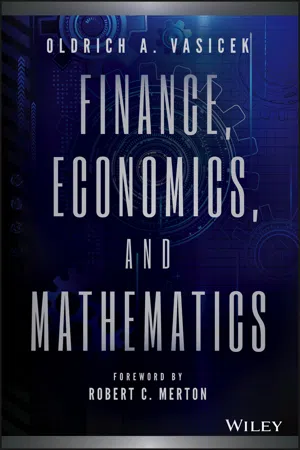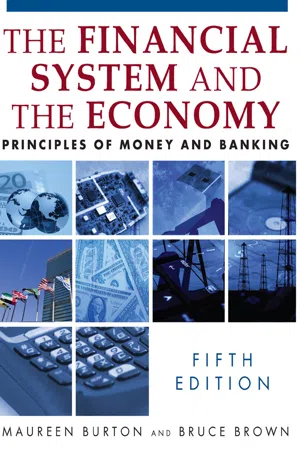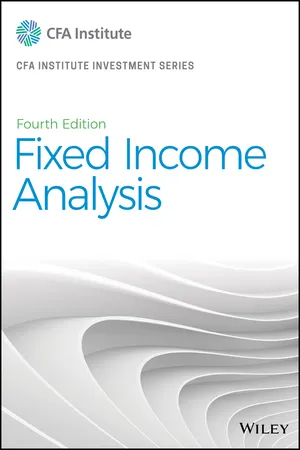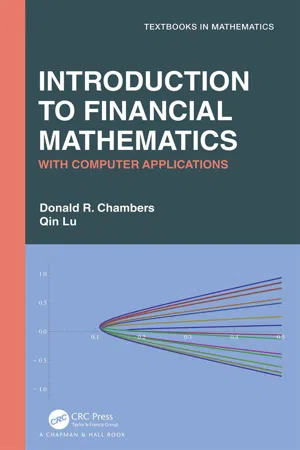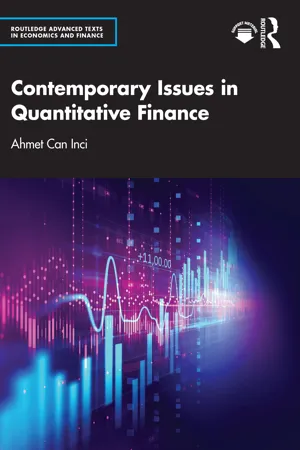Business
Term Structure
Term structure refers to the relationship between the yields and maturities of fixed-income securities. It is often depicted in a yield curve, which shows the interest rates of bonds with different maturity dates. The term structure is important for businesses as it provides insights into future interest rate movements, which can impact borrowing costs and investment decisions.
Written by Perlego with AI-assistance
Related key terms
Related key terms
1 of 4
Related key terms
1 of 3
12 Key excerpts on "Term Structure"
- eBook - ePub
The Creators of Inside Money
A New Monetary Theory
- D. Gareth Thomas(Author)
- 2018(Publication Date)
- Palgrave Macmillan(Publisher)
The Term Structure of interest rates, however, recognises a common link between them all in the form of expectations of the future, whether long or short, which determines the holding of various financial assets of maturity as well as influencing the determination of aggregate demand and supply within the real economy. The Term Structure, therefore, is important for Central Bank ’s policymakers. If these monetary instruments affect short-term rates of interest in the first instance, which leads to the determination of long-term rates of interest, which drives capital and consumption expenditure, then analysing the Term Structure is crucial for understanding the transmission mechanism of monetary policy (Fender 2012). 1 Nevertheless, it is also relevant for many households in terms of the portfolio choice of assets. Suppose a family requires expenditure on private school fees in ten years’ time and decides to save now. There are a number of options. They could save by investing into a ten-year bond. Alternatively, they could purchase a short-term bill and then take the earnings into another bond each time it matures, until the ten years are up. Clearly, the important components determining the choice will be the expected return (or cost) and the risk involved, embodied in the Term Structure. Therefore, the analysis must consider the various theoretical models put forward in the literature to explain the relationship between interest rates on bonds (or bills) of differing maturity, although the hypothesis can applied to other assets as diverse as housing and the mortgage rate. The foremost theory of the Term Structure of interest rates is the so-called expectations hypothesis, which focuses on the rôle of expectations of future short-term interest rates in the determination of prices and yields on longer-term bills (or bonds). There a number of ways in which the theory in the literature differs in terms of the length of the bills (or bonds) included in the analysis - eBook - ePub
- Frank J. Fabozzi, Frank J. Fabozzi(Authors)
- 2012(Publication Date)
- Wiley(Publisher)
The Dynamic Term Structure Model DAVID AUDLEY, PhD Senior Lecturer, The Johns Hopkins University RICHARD CHIN Investment Manager, New York Life Investments PETER C. L. LIN PhD Candidate, The Johns Hopkins University SHRIKANT RAMAMURTHY Consultant, New York, NY Abstract: The Term Structure of interest rates represents the cost of (return from) borrowing (lending/investing) for different terms at any one moment in time. The Term Structure is most often specified for a specific market such as the U.S. Treasury market, the bond market for double A rate financial institutions, the interest rate market for LIBOR and swaps, and so on. The Term Structure is usually specified via a rate or yield for a given term or the discount to a cash payment at some time in the future. These are often summarized mathematically through a wide variety of models. In addition, Term Structure models are fundamental to expressing value, risk, and establishing relative value across the spectrum of instruments found in the various interest-rate or bond markets. Dynamic models of the Term Structure are characterizations that are specifically established to consider future market scenarios where there is uncertainty. As such they are rooted in probability, stochastic process, and martingale theory. Standard models include those derived from assumptions that include a short-rate or a forward rate process as an explanatory factor for the evolution of markets. Instantiations of these models include a general zero-coupon bond pricing equation 2nd the LIBOR market model. An important consideration includes expressing the market price of risk that allows for the complexity of the Term Structure of interest rates to exist without arbitrage, as found from the traded markets - eBook - ePub
- Oldrich A. Vasicek(Author)
- 2015(Publication Date)
- Wiley(Publisher)
Part Two Term Structure of Interest Rates The price at time t of a default-free zero-coupon bond with unit face value maturing at time s is given by the equation where is the short interest rate, is a Wiener process constituting a source of risk, and is the market price of risk. (page 38) Chapter 5 Introduction to Part II Interest rates are a function of time and term (time to maturity). As a function of time, rates behave as stochastic processes. As a function of term, interest rates on a given date form a yield curve. Term Structure models describe the behavior of interest rates of different maturities as a joint stochastic process. Term Structure models are a necessary tool for valuation and risk management of interest rate contingent claims—that is, securities or transactions whose payoff depends on future values of interest rates, such as callable or putable bonds, swaps, swaptions, caps, and floors. For instance, a bond will be called if its value on the call date is greater than the call price. To determine the current value of the bond, it is necessary to know the subsequent behavior of interest rates. The same is true for all debt securities subject to prepayment, such as mortgages with refinancing options. The immediate acceptance and application of Term Structure models in banking and investment practice is due to the fact that there are few financial instruments whose value is not in some degree dependent on future interest rates. Even stock options such as calls and puts depend on the development of interest rates. Interest rate models enter into valuation of firms and their liabilities. Besides valuation, Term Structure models are necessary for interest rate risk measurement, management, and hedging. Interest rates of different maturities behave as a joint stochastic process. Not all joint processes, however, can describe interest rate behavior in an efficient market - eBook - ePub
- Frank J. Fabozzi, Frank J. Fabozzi(Authors)
- 2012(Publication Date)
- Wiley(Publisher)
Usually, a quantitative theory about the Term Structure of interest rates culminates in a mathematical model, a Term Structure model that exhibits useful properties. Specifically, a Term Structure model is the mathematical representation of the relationship among the securities in a market sector. This formalizes the distinction between the reference set used to define a market sector and a Term Structure model.Term Structure MODELSThe simplest and most familiar Term Structure model is the (semilogarithmic) graph of the U.S. Treasury yield curve (once found daily in the Wall Street Journal and in the business section of many newspapers). This model is useful mainly as a visualization of the yield relationship between the most recently issued shorter-term Treasury instruments and bonds. The graph can be characterized by a mathematical equation and is one example of the set of interpolation models of the Term Structure. These “connect-the-dots” models can be useful in providing a quantitative way to price bonds outside the current-coupon Treasury issues, but their utility is rather limited. Bonds that are valued through a linear-interpolation technique may not be “fairly” valued in the sense that an average yield may not be equal to the “par-coupon” yield corresponding to the same date. Later we provide a discussion of how the par-coupon curve is constructed to be fairly valued in comparison to the set of reference (Treasury) issues.The Term Structure model as described above simply provides a snapshot of the relationship between the yields for selected Treasury maturities on a given day. It is often required that Term Structure models exhibit additional “analytic” properties. One such property is the consistency associated with the preclusion of riskless arbitrage when the Term Structure model is used for pricing. More will be said about this later. For now, it is intended merely to indicate that the “visualization” of the yield relationship to term may be neither completely useful nor adequate.More generally, Term Structure models are called on to describe the evolution of a set of interest rates over time. This motivates the following distinction in classifying Term Structure models: - eBook - ePub
The Financial System and the Economy
Principles of Money and Banking
- Maureen Burton, Bruce Brown(Authors)
- 2014(Publication Date)
- Routledge(Publisher)
yield curve is a graphical representation of the relationship between interest rates (yields) on particular financial instruments (securities) and their terms to maturity. Put another way, a yield curve visually represents the Term Structure of interest rates—that is, it shows how interest rates vary with the term to maturity.When constructing yield curves for the purpose of examining the role of term to maturity in explaining interest rate differentials, analysts traditionally focus on Treasury securities. By concentrating on one particular type of security, we can control for factors other than term to maturity, such as riskiness and tax treatment, which could also affect the structure of yields.2 In other words, focusing on Treasury securities permits us to isolate the effects of term to maturity. Although we use U.S. government securities, we could have used other types of assets to demonstrate yield curves. Other financial instruments (securities) that could be used include corporate bonds with the same default risk (and other non-maturity-related characteristics) or municipal bonds. Just be sure you understand that each individual asset is usually represented on a single yield curve, even though several yield curves may be drawn on one graph.To construct yield curves, we begin with Exhibit 6-1 . This table shows the interest rates on U.S. Treasury securities of different maturities prevailing on four different dates: January 16, 1981; January 29, 1993; June 1, 2003; and May 7, 2007. From this information, we can construct four different yield curves—one for each of the four dates. Term to maturity is always measured on the horizontal axis, while the return on an asset (yield to maturity) is measured on the vertical.Using the data in Exhibit 6-1 , the yield curves for the four dates are plotted in Exhibit 6-2 - eBook - ePub
- Friedrich A. Lutz(Author)
- 2017(Publication Date)
- Routledge(Publisher)
If a lender knows exactly how long his money will be available for investment, he can select the maturity date of the claim in such a way that he runs neither an income risk nor a capital risk. If he chooses a maturity date earlier than the point in time at which he needs cash, he will not run the risk of a capital loss since he can always invest his money a second time for the “correct” date, but he runs an income risk since the rate of interest obtainable on the second investment may be lower. If, on the other hand, he selects a maturity date later than the date on which he needs his money, his income from the investment will be certain, but not the capital value. Only the coincidence of the maturity date of the claim and the date of his need for cash will insure him simultaneously against both types of risk – that is, insure him against what we shall call yield risk (yield = interest plus capital gain or minus capital loss).If we assumed the relevant dates to be known and all participants in the market to be intent exclusively on avoiding any risk, the capital market would consist of a great number of tightly sealed compartments, one for each maturity date, in which the supply of and demand for bonds of each given maturity would determine the interest rate on these bonds irrespective of what happened in the other compartments. The Term Structure of interest rates would then be determined exclusively by the maturity structure in which debtors wanted to borrow money on the one hand, and on the other hand by the maturity structure in which owners of funds wanted to invest their money. If on the demand side the demand for long-term capital were to predominate and on the supply side the offer of short-term money, the long rates would come to lie above the short rates, and vice versa in the opposite case. Under the “expectation theory”, by contrast, the maturity structure of claims or debts has no influence at all on the Term Structure of interest rates as long as perfect foresight or at least the absence of risk aversion is assumed.It was Culbertson who more than anybody else stressed the maturity structure of debts as an important – although not the only – factor determining the Term Structure of interest rates.5 On this theory the rate structure can be influenced to a significant degree by the debt management policies of the government, as for instance when it shifts from short-term into long-term debt or vice versa. Changes in the economic structure also influence the structure of interest rates, since the length of time for which debts are incurred changes with the purpose for which borrowing is effected. Accordingly, Culbertson points out that “shifts in business and financial developments tend to be reflected in changes in the maturity structure of borrowing. Business inventory developments and securities speculation are reflected in changes in short-term borrowing; changes in automobile sales affect extensions of the intermediate-term credit commonly used in this area; changes in sales of new houses, in business fixed investment, in state and local government construction are reflected in demands for new long-term credit”.6 - eBook - ePub
- (Author)
- 2021(Publication Date)
- Wiley(Publisher)
describe relationships among spot rates, forward rates, yield-to-maturity, expected and realized returns on bonds, and the shape of the yield curve- describe how zero-coupon rates (spot rates) may be obtained from the par curve by bootstrapping
Interest rates are both a barometer of the economy and an instrument for its control. The Term Structure of interest rates—market interest rates at various maturities—is a vital input into the valuation of many financial products. The quantification of interest rate risk is of critical importance to risk managers. Understanding the determinants of interest rates, and thus the drivers of bond returns, is imperative for fixed-income market participants. Here, we explore the tools necessary to understand the Term Structure and interest rate dynamics—that is, the process by which bond yields and prices evolve over time.Section 1 explains how spot (or current) rates and forward rates, which are set today for a period starting in the future, are related, as well as how their relationship influences yield curve shape. Section 2 builds upon this foundation to show how forward rates impact the yield-to-maturity and expected bond returns. Section 3 explains how these concepts are put into practice by active fixed-income portfolio managers.The swap curve is the Term Structure of interest rates derived from a periodic exchange of payments based on fixed rates versus short-term market reference rates rather than default-risk-free government bonds. Sections 4 and 5 describe the swap curve and its relationship to government yields, known as the swap spread, and explains their use in valuation. - eBook - ePub
- Barbara S. Petitt(Author)
- 2019(Publication Date)
- Wiley(Publisher)
Solution to 5: A is correct. Although the local expectations theory predicts that the short-run return for all bonds will be equal to the risk-free rate, most of the evidence refutes that claim. Returns from long-dated bonds are generally higher than those from short-dated bonds, even over relatively short investment horizons. This market evidence is consistent with the risk–expected return trade-off that is central to finance and the uncertainty surrounding future spot rates.5. Modern Term Structure Models
Modern Term Structure models provide quantitatively precise descriptions of how interest rates evolve. A model provides a sometimes simplified description of a real-world phenomenon on the basis of a set of assumptions; models are often used to solve particular problems. These assumptions cannot be completely accurate in depicting the real world, but instead, the assumptions are made to explain real-world phenomena sufficiently well to solve the problem at hand.Interest rate models attempt to capture the statistical properties of interest rate movements. The detailed description of these models depends on mathematical and statistical knowledge well outside the scope of the investment generalist’s technical preparation. Yet, these models are very important in the valuation of complex fixed-income instruments and bond derivatives. Thus, we provide a broad overview of these models in this chapter. Equations for the models and worked examples are given for readers who are interested.5.1. Equilibrium Term Structure Models
Equilibrium Term Structure models are models that seek to describe the dynamics of the Term Structure using fundamental economic variables that are assumed to affect interest rates. In the modeling process, restrictions are imposed that allow for the derivation of equilibrium prices for bonds and interest rate options. These models require the specification of a drift term (explained later) and the assumption of a functional form for interest rate volatility. The best-known equilibrium models are theEquilibrium Term Structure models share several characteristics:Cox–Ingersoll–Ross model10 and theVasicek model,11 which are discussed in the next two sections.- They are one-factor or multifactor models. One-factor models assume that a single observable factor (sometimes called a state variable) drives all yield curve movements. Both the Vasicek and CIR models assume a single factor, the short-term interest rate, r
- eBook - ePub
Introduction to Financial Mathematics
With Computer Applications
- Donald R. Chambers, Qin Lu(Authors)
- 2021(Publication Date)
- Chapman and Hall/CRC(Publisher)
In this section, we will derive various interest rates as a function of time using different bond prices. Perhaps the most straightforward way to value future cash flows is through the discount factor function – the relationship between discount factors and time-to-maturity. Using continuous compounding, the time value discount factor function is simply e −rT. There are three equivalent ways to represent the time value of money: the time value discount factor function, the Term Structure of interest rates, and forward interest rate structures (to be discussed later). Each can be derived from the other. Another concept introduced in this section is the yield curve. The yield curve is an ambiguous and vague concept. A yield curve is an expression of the relationship between bond yields and their times to maturity. Though it is used in practice, it has little mathematical or financial economic meaning. 2.2.1 The Bootstrap Method for Treasury Zero Coupon Interest Rates and the Term Structure of Interest Rates The Term Structure of interest rates is the relationship between zero coupon interest rates and their corresponding terms to maturity. Henceforth, we will not distinguish the following synonymous terms: zero coupon interest rates, zero rates, and the zero coupon Term Structure. The Term Structure is usually depicted with rates on the vertical axis and time to maturity on the horizontal axis, as shown in Figure 2.1. Figure 2.1 The Term Structure of Interest Rates. While zero coupon debt securities are common in maturities of less than one year, most bonds with maturities beyond one year offer coupons. Some investors prefer zero coupon bonds in order to avoid the risk and inconvenience of reinvesting coupon payments at unknown future interest rates (reinvestment rate risk) - eBook - ePub
- Suresh Sundaresan(Author)
- 2009(Publication Date)
- Academic Press(Publisher)
stripping coupon-paying bonds and reconstitutions of strips into coupon bonds.8.1 Yield-Curve Analysis
Yield curve is a term used to describe the plot of yield to maturity against time to maturity or against a risk measure, such as the modified duration of debt securities in a certain market segment (such as Treasury or corporate bonds). It is therefore natural to speak of “Treasury yield curve” or “corporate AAA yield curve.” By incorporating the expectations of diverse participants in the marketplace, the shape of the yield curve succinctly captures and summarizes the cost of credit for various maturities of different issuers. The shape of the default-free yield curve is, therefore, of considerable interest to practitioners in the financial markets. To get some basic understanding of this concept, we plot the yield to maturity along the Y axis and time to maturity along the X axis using all 160 Treasury debt securities that were outstanding for settlement on July 11, 2008. Figure 8.1 shows the resulting plot of the yield curve as of that date.Figure 8.1 Treasury Yield Curve quoted as of July 11, 2008Source: Wall Street Journal.Several features of the yield curve are worth noting. First, note the sparseness of yield data for maturities in the range 2029 through 2035. This is due to the fact that 30-year T-bond auctions were cancelled during the period March 2001 to January 2006 and were only resumed in February 2006. Second, the yield curve is relatively flat in the far end (longer maturity sector) and somewhat steep in the front maturities. Finally, we note that there are some debt securities whose yields plot well outside the general area around which the yields have clustered. Even within the same maturity range, yields tend to differ. Some of the outstanding debt issues were callable, and not surprisingly these were trading at a higher yield. We explore this activity later in the chapter. - eBook - ePub
- Ahmet Can Inci(Author)
- 2023(Publication Date)
- Routledge(Publisher)
There are many more stochastic models for interest rate dynamics. However, the ones explored here are the most popular and most useful models. The stochastic equations covered earlier can be used to drive the expressions for bond prices using equation 11.11. Most of the models presented here are one-factor models. One random variable, and therefore, one economic variable – the short-term interest rate – is the driver of all the interest rates. The single factor is present as a linear factor in all the stochastic equations. As a consequence, the models in equations 11.12 through 11.17 are known also as affine models of interest rates with respect to the random factor.11.7 Term Structure OF INTEREST RATES
The Term Structure of interest rates, or the yield curve, is a graph of the yields of bonds plotted against their maturities. The bonds have as little frictional risk as possible; by focusing on government bonds, liquidity risks and bankruptcy risks are avoided. The yield curve using only government bonds is typically upward-sloping, as in Figure 11.2 , considered indicative and predictive of a healthy economy. On the other hand, an inverted (downward-sloping) yield curve predicts a recession. Humped-shaped or flat-Term Structures are also possible from time to time.The Typical Term Structure of Interest Rates in a Normal EconomyFIGURE11.2Researchers are interested in the shape of the Term Structure of interest rates from two perspectives: (1) Why is there a certain shape of the Term Structure? (2) How can the shape of the Term Structure be predicted so that this predictive power of the Term Structure over the economy and financial markets helps make advanced and better investment rebalancing decisions?To address the first perspective, why the shape of the Term Structure, researchers have proposed and tested several Term Structure theories:-
Pure expectations theory: This theory suggests that short-term rates can be used in conjunction with forward rates to predict longer-term interest rates. For example, the two-year bond yield can be determined from the one-year bond yield and the forward rate of a 1-year bond which will be active during the following year:
- eBook - ePub
- Eliezer Z Prisman(Author)
- 2017(Publication Date)
- WSPC(Publisher)
m times per unit of time, will be the solution toThus, if the unit of time is half a year and the rates are reported per annum based on semiannual compounding, a dollar invested from time zero to time three is invested for 1.5 years and will grow to3.1.1 Zero-Coupon, Spot, and Yield Curves
The Term Structure, Zero-Coupon, and Spot Curves
The Term Structure is actually a function, which we will denote by r (t), that relates time to the interest rate prevailing in the market. For each t, r (t) is the interest rate per period (a year) paid for a dollar invested for t years, from time zero to time t. We keep our units of time measured in years and report the interest rate based on semiannual compounding. Hence, r (t) is the rate such that a dollar invested from time zero to time t will grow to beat time t. This function is referred to as the Term Structure of interest rates, and for each t the rate r (t) is called a spot rate.These are the rates paid on an investment over a period that starts now (on the spot) and ends at some future time t. The graph of this function is sometimes referred to as the spot curve or the zero-coupon curve. In what follows, we justify this name followed by a graphical representation of the Term Structure which will be explored shortly afterward.Certain bonds pay only one payment at the maturity time of the bond. These bonds are referred to as zero-coupon bonds, since they make no coupon payments. Furthermore, zero-coupon bonds are sold at a discount. The interest rate offered by such bonds is implicit in the difference between the face value of the bond and its market price. Namely, if the price of a zero-coupon bond maturing at time t, t years from now, is P and its face value is $100, the interest it pays is the solution r
Index pages curate the most relevant extracts from our library of academic textbooks. They’ve been created using an in-house natural language model (NLM), each adding context and meaning to key research topics.
Explore more topic indexes
Explore more topic indexes
1 of 6
Explore more topic indexes
1 of 4


